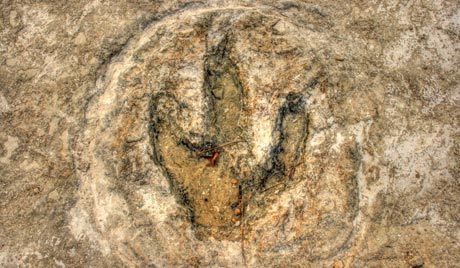Jurassic India – Scientists Find Rare Prehistoric Tracks in Rajasthan
Trace Fossils Including Pterosaur Trackways Discovered in Rajasthan
The north-western province of Rajasthan in India has some spectacular limestone formations that represent sediments laid down in the Middle Jurassic. A number of expeditions have been mounted to this part of India by institutions such as the University of Rajasthan to help map the geology and assess the many different types of marine invertebrate fossils that are associated with some parts of this strata.
Jurassic India
The specimens of ammonites are very useful in helping scientists to accurately date the age of these formations (biostratification) and for comparing the fauna found in these deposits with other sedimentary rock formations found elsewhere on the sub-continent. Although, the area’s close proximity to the Pakistan border has led to difficulties over accessing some parts of the region, a number of geological surveys have been carried out exploring for reserves of natural gas and oil. The limestone represent deposition in a marine environment, however, Jurassic sandstones that are also to be found in Rajasthan, most notably in Jaisalmer district, represent material deposited in a fluvial (river) environment. These outcrops and the fossils contained therein are providing scientists with a fascinating glimpse into life in the Early to Middle Jurassic.
Palaeontologists and geologists visiting this part of India as part of their participation in the ninth annual International Congress on the Jurassic System, organised by the Geology department of Rajasthan University, have been taking the opportunity to explore the area and to look for fossils. An outcrop of exposed Jurassic aged sediments on the Jodhpur-Jaisalmer highway, close to the village of Thaiat has yielded a number of trace fossils including pterosaur and three-toed dinosaur footprints.
An International Team of Scientists
The thirty-four strong party, including researchers from France and Germany have been staying in this area, with a view to mapping the formations and recording evidence of Jurassic vertebrates. Little is known about the evolution of the Dinosauria and the Pterosauria (flying reptiles) in this part of the world during the Early Jurassic.
The footprint fossils may potentially belong to species that are new to science. Dr Jan Schlogl of Slovakia working in collaboration with Professor Gregory Pienkowski (Poland), identified the footprints, preserved in finely grained, sandstone sediments as those belonging to a pterosaur (flying reptile). Something like over 120 different pterosaur species are now known, mostly via fragmentary fossil remains. Finding pterosaur tracks in these sediments, believed to date from around 180 million years ago, will help scientists to understand better the evolution and radiation of these vertebrates.
Jurassic Trace Fossils – Trackways
Amongst the footprints representing Jurassic dinosaurs at least two kinds have been identified. Firstly, there are the small three-toed prints of a little theropod dinosaur known as Grallator. The name Grallator is an ichnogenus, a name given to a genus of animal that is only known from trace fossils. Some of the prints, representing the hind feet of this biped are five centimetres in length. It is likely that this little dinosaur was about the size of a chicken.
Larger three-toed prints have also been identified. These tridactyl (three-toed) prints measure approximately thirty centimetres long and must have been made by a much larger creature. It is difficult to speculate what sort of dinosaur made such prints, but similar prints found in European strata of roughly the same geological age have been assigned to Tetanurae theropods such as megalosaurs, whereas, it is possible that these prints could represent another type of theropod such as a member of the Neoceratosauria or a coelophysid.
Rapidly Evolving Theropods
During the Early Jurassic the Theropoda group of meat-eating dinosaurs rapidly evolved and a number of new families evolved. If body fossils of meat-eating dinosaurs can be found in these sediments then this would add greatly to our knowledge of theropod dinosaurs from the southern super-continent of Gondwana.
Large Three-Toed Dinosaur Footprints Discovered
Picture credit: University of Rajasthan
The larger, tridactyl prints have been assigned to the ichnogenus Eurontes (Eurontes giganteus).
Associate Professor P. K. Pandey (Geology department of the University of Rajasthan), has studied a number of Jurassic aged fossils from these sandstone deposits. He has already recorded the presence of small pterosaurs after finding fragmentary fossilised bones in these deposits. A source close to Everything Dinosaur commented that these discoveries of dinosaur footprints and pterosaur footprints were very significant.
For models and replicas of Jurassic theropods and other prehistoric animals: CollectA Deluxe Scale Prehistoric Animal Models.


